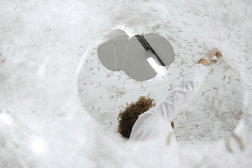
September 2020
Dear EarthTalk: Can you explain the concept of “Material Ecology” as advertised in a new Museum of Modern Art exhibit? ~ Nancy R., New York, NY
Israeli-born designer and architect Neri Oxman, founding director of the Mediated Matter Group at the Massachusetts Institute of Technology’s Media Lab, coined the term Material Ecology to describe a process of combining materials science, digital fabrication technologies and organic design to produce techniques and objects informed by the structural, systemic and aesthetic wisdom of nature.

Oxman’s vision involves harnessing biological impulses to grow and build in the pursuit of developing structures out of natural elements alongside man-made designs and parts. “It is the definition of ecology—the branch in biology that deals with the relations between organisms and their physical surroundings—applied to all things man-made or human-designed,” she tells Dezeen. “Biology is far more refined and sophisticated than material practices involved in polymers, concrete, steel and glass,” she adds. “But what if we could change that by creating new technologies that can vary the physical properties of matter at a resolution and sophistication that approaches that of the natural world?”
The best-known example of Oxman’s work to date is the so-called Silk Pavilion, first conceived at MIT in 2013, whereby 6,500 silkworms were fed and released onto a human-designed, robot-created cocoon-like dome structure, eventually completing the human/natural architecture by weaving a silk cover.
Animal rights activists might at first be alarmed at the concept of enslaving silkworms to make use of their biological product for human benefit, but taking a wider view of the situation affords a more humane conclusion. Oxman points out that the traditional process of harvesting silk (“sericulture”) kills silkworm larva, effectively sacrificing the next generation of silkworms for the sake of producing silk.
“In the textile and silk industry today, silkworms are exterminated while in their cocoon, dissolving the adhesive that glues one strand of silk to the layers below,” reports Oxman. “This process allows a single silk strand to be unrolled from the cocoon, but disrupts the life cycle and development of the organism.”
But in creating the silk cover for the pavilion, the silkworms’ product ends up in use as strands in the structure’s cover instead of as the walls of a cocoon; no silkworms-to-be are harmed.
Oxman hopes her work can highlight that, with creative thinking, we can overcome the limitations of “additive manufacturing” (e.g., 3D printing) at architectural scales. Currently the small size of 3D printers restricts the usefulness in real-world applications for this emerging technology. Putting 3D printers on huge robotic arms and combining the technology with natural forms of building (like the silkworm’s silk) could revolutionize how we build. “In the future, we will not build our products and our architecture; rather we will grow them,” Oxman predicts. “But it will take a village, not a lab.”
To see more of Oxman’s work and find out more about the fast-evolving world of Material Ecology, check out the Museum of Modern Art’s virtual exhibit “Neri Oxman: Material Ecology” which runs February 22-May 25, 2020.
Dear EarthTalk: Is it true that my avocado habit is bad for the environment and my carbon footprint? ~ J. Pilsen, Olathe, KS
Compared to other fruits and vegetables that are grown closer to home, eating avocados—most of which are flown in from Central America—can be a drag on your carbon footprint. Furthermore, they require a lot of water, fertilizers and pesticides to grow, further complicating this seemingly “green” superfood.
Avocado’s environmental impacts come from the “energy, water, fertilizer and pesticides required to grow them, the resources used for packaging materials and the energy used in processing, transporting and keeping them cool to preserve their freshness,” Tom Cumberlege of Carbon Trust tells Vice.com, also pointing out that some of the biggest markets for avocados are in the UK, northern Europe and Canada.”

Despite that avocados can now be grown around the world, the majority of them (upwards of two metric tons annually) come from Mexico. “A Mexican avocado would have to travel 5,555 miles to reach the UK,” reports Honor May Eldridge of the non-profit Sustainable Food Trust. “Given the distances, fruit is picked before it’s ripe and shipped in temperature-controlled storage, which is energy intensive.”
Avocados also require an astonishing amount of water to grow, some 320 liters per fruit. “The UK’s imports of avocados contain over 25 million cubic meters annually of virtual water—equivalent to 10,000 Olympic-sized swimming pools,” reports Eldridge. “With global temperatures rising and water becoming scarce, this has serious impacts on local communities who do not have access to drinking water.”
Furthermore, the global popularity of avocados in recent years has led to “monoculture” farms that grow only one crop over and over, degrading soil quickly and requiring increasingly more chemical fertilizers and pesticides. Surging demand has also led to rampant deforestation, especially in areas like Mexico’s mountainous Michoacán. A researcher from Mexico’s National Institute for Forestry found that avocado production there tripled there from 2001-2010—causing the loss of some 1,700 acres of forest annually.
Compared to meat, avocados are still a much better deal for the environment—and much less of a drag on your carbon footprint. Indeed, the Evening Standard reports that eating a kilo of lamb generates some 46 times the carbon emissions as the average pack of avocados. Enjoying a piece of farmed salmon will also increase your carbon footprint more than having some guacamole or avocado toast every now and again.
As a consumer, the best thing you can do with an avocado is to “make sure that it doesn’t go to waste,” says Cumberlege. “… avocados will not last days in the fridge after they have been prepared, so [they] should be enjoyed sooner rather than later.”
EarthTalk® is produced by Roddy Scheer & Doug Moss for the 501(c)3 EarthTalk.
See more at https://emagazine.com. To donate, visit https://earthtalk.org.
Send questions to: question@earthtalk.org

